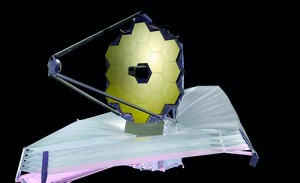Sunday Times 2
We’ll find alien life in 20 years
One hundred million worlds in our galaxy are able to host alien life, according to a ‘conservative’ prediction by Nasa.
And the space agency claims that we will be able to find that life within the next 20 years, with a high chance it will be outside our solar system.

The James Webb Space Telescope (artist's concept above) will be one of the primary instruments scientists use to continue the search for planets outside our solar system(NASA)
During a public talk yesterday in Washington, the space agency outlined a roadmap to search for life in the universe using a number of current and future telescopes.
‘Do we believe there is life beyond Earth?’ said former astronaut and Nasa Administrator Charles Bolden.
‘I would venture to say that most of my colleagues here today say it is improbable that in the limitless vastness of the universe we humans stand alone.’ Mars and a number of moons in our solar system have been the focus of the search for alien life for decades.
For instance, astronomer Kevin Hand recently suggested alien life could exist on Jupiter’s moon Europa.
But the Nasa scientists on the panel spoke exclusively about looking for signs of life on planets around other stars outside our solar system.
‘Sometime in the near future, people will be able to point to a star and say, “that star has a planet like Earth”,’ said Sara Seager, professor of planetary science and physics at the Massachusetts Institute of Technology in Cambridge, Massachusetts.
‘Astronomers think it is very likely that every single star in our Milky Way galaxy has at least one planet.’
Nasa first began studying planetary systems around other stars with ground-based observatories.
It then moved to space-based assets like the Hubble Space Telescope, the Spitzer Space Telescope, and the Kepler Space Telescope.
These telescopes can determine if the planets are the right distance away from the star to have liquid water, the key ingredient to life as we know it.
Nasa is now hoping to launch of the Transiting Exoplanet Surveying Satellite (Tess) in 2017, the James Webb Space Telescope in 2018, and potentially the proposed Wide Field Infrared Survey Telescope – Astrophysics Focused Telescope Assets early in the next decade.
‘This technology we are using to explore exoplanets is real,’ said John Grunsfeld, astronaut and associate administrator for Nasa’s Science Mission Directorate in Washington.
‘The James Webb Space Telescope and the next advances are happening now. These are not dreams – this is what we do at Nasa.’
During a question-and-answer session, someone using social media, asked: ‘If scientists do find life on another planet, will the U.S. government let people know?’
Ellen Stofan, chief scientist at Nasa said, ‘Of course we would!’
‘That would be so amazingly exciting. We would try to get it out to the public as fast as we can. We want everyone to share in the excitement of discovery.’
Finding smaller planets that are the Earth’s ‘twin’ is difficult because they produce fainter signals.
Technology to detect and image these Earth-like planets is being developed now for use with the future space telescopes. The ability to detect alien life may still be years or more away, but the quest is underway.
‘Just imagine the moment, when we find potential signatures of life,’ Professor Mountain said.
‘Imagine the moment when the world wakes up and the human race realises that its long loneliness in time and space may be over – the possibility we’re no longer alone in the universe.’
© Daily Mail, London
| THE KEPLER LEGACY
Since its launch in 2009, Kepler has dramatically changed what scientists know about exoplanets, |

